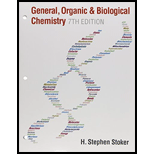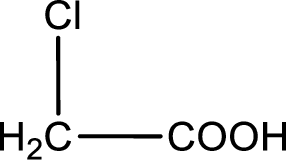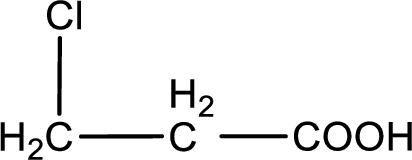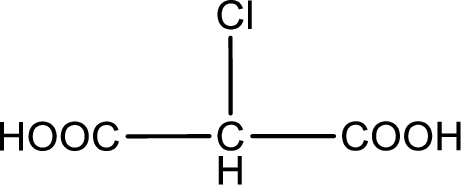
(a)
Interpretation:
Condensed structural formula has to be drawn for the given
Concept Introduction:
The structural representation of organic compound can be done in 2D and 3D. In two-dimensional representation, there are four types of representation in which an organic compound can be drawn. They are,
- Expanded structural formula
- Condensed structural formula
- Skeletal structural formula
- Line-angle structural formula
Structural formula which shows all the atoms in a molecule along with all the bonds that is connecting the atoms present in the molecule is known as Expanded structural formula.
Structural formula in which grouping of atoms are done and in which the central atoms along with the other atoms are connected to them are treated as group is known as Condensed structural formula.
Structural formula that shows the bonding between carbon atoms alone in the molecule ignoring the hydrogen atoms being shown explicitly is known as Skeletal structural formula.
Structural formula where a line represent carbon‑carbon bond and the carbon atom is considered to be present in each point and the end of lines is known as Line-angle structural formula.

(a)
Answer to Problem 16.30EP
The condensed structural formula is,

Explanation of Solution
Given description about the carboxylic acid is chloroacetic acid.
In the problem statement it is given how the carboxyl group has to be denoted. From the common name it is understood that the carboxylic acid is a two carbon monocarboxylic acid. The chlorine atom is substituted in the another carbon atom. Therefore, the structure can be drawn as shown below,

The condensed structural formula for the given carboxylic acid is drawn.
(b)
Interpretation:
Condensed structural formula has to be drawn for the given carboxylic acid.
Concept Introduction:
The structural representation of organic compound can be done in 2D and 3D. In two-dimensional representation, there are four types of representation in which an organic compound can be drawn. They are,
- Expanded structural formula
- Condensed structural formula
- Skeletal structural formula
- Line-angle structural formula
Structural formula which shows all the atoms in a molecule along with all the bonds that is connecting the atoms present in the molecule is known as Expanded structural formula.
Structural formula in which grouping of atoms are done and in which the central atoms along with the other atoms are connected to them are treated as group is known as Condensed structural formula.
Structural formula that shows the bonding between carbon atoms alone in the molecule ignoring the hydrogen atoms being shown explicitly is known as Skeletal structural formula.
Structural formula where a line represent carbon‑carbon bond and the carbon atom is considered to be present in each point and the end of lines is known as Line-angle structural formula.

(b)
Answer to Problem 16.30EP
The condensed structural formula is,

Explanation of Solution
Given description about the carboxylic acid is
In the problem statement it is given how the carboxyl group has to be denoted. From the common name it is understood that the carboxylic acid is a three carbon monocarboxylic acid. The chlorine atom is substituted in the beta carbon atom. Beta carbon atom in carboxylic acid is the one that is the second carbon atom from the carboxyl group. Therefore, the structure can be drawn as shown below,

The condensed structural formula for the given carboxylic acid is drawn.
(c)
Interpretation:
Condensed structural formula has to be drawn for the given carboxylic acid.
Concept Introduction:
The structural representation of organic compound can be done in 2D and 3D. In two-dimensional representation, there are four types of representation in which an organic compound can be drawn. They are,
- Expanded structural formula
- Condensed structural formula
- Skeletal structural formula
- Line-angle structural formula
Structural formula which shows all the atoms in a molecule along with all the bonds that is connecting the atoms present in the molecule is known as Expanded structural formula.
Structural formula in which grouping of atoms are done and in which the central atoms along with the other atoms are connected to them are treated as group is known as Condensed structural formula.
Structural formula that shows the bonding between carbon atoms alone in the molecule ignoring the hydrogen atoms being shown explicitly is known as Skeletal structural formula.
Structural formula where a line represent carbon‑carbon bond and the carbon atom is considered to be present in each point and the end of lines is known as Line-angle structural formula.

(c)
Answer to Problem 16.30EP
The condensed structural formula is,

Explanation of Solution
Given description about the carboxylic acid is chloromalonic acid.
In the problem statement it is given how the carboxyl group has to be denoted. From the common name it is understood that the carboxylic acid is a three carbon dicarboxylic acid. The chlorine atom is substituted in the carbon atom that is present in middle of the two carboxyl groups. Therefore, the structure can be drawn as shown below,

The condensed structural formula for the given carboxylic acid is drawn.
(d)
Interpretation:
Condensed structural formula has to be drawn for the given carboxylic acid.
Concept Introduction:
The structural representation of organic compound can be done in 2D and 3D. In two-dimensional representation, there are four types of representation in which an organic compound can be drawn. They are,
- Expanded structural formula
- Condensed structural formula
- Skeletal structural formula
- Line-angle structural formula
Structural formula which shows all the atoms in a molecule along with all the bonds that is connecting the atoms present in the molecule is known as Expanded structural formula.
Structural formula in which grouping of atoms are done and in which the central atoms along with the other atoms are connected to them are treated as group is known as Condensed structural formula.
Structural formula that shows the bonding between carbon atoms alone in the molecule ignoring the hydrogen atoms being shown explicitly is known as Skeletal structural formula.
Structural formula where a line represent carbon‑carbon bond and the carbon atom is considered to be present in each point and the end of lines is known as Line-angle structural formula.

(d)
Answer to Problem 16.30EP
The condensed structural formula is,

Explanation of Solution
Given description about the carboxylic acid is
In the problem statement it is given how the carboxyl group has to be denoted. From the common name it is understood that the carboxylic acid is a four carbon dicarboxylic acid. The chlorine atom is substituted in the alpha carbon atom and gamma carbon atom. Alpha carbon atom in carboxylic acid is the one that is attached to the carboxyl group and the next carbon attached to the alpha carbon atom is the beta carbon atom. The carbon atom bonded to the beta carbon atom is the gamma carbon atom. Therefore, the structure can be drawn as shown below,

The condensed structural formula for the given carboxylic acid is drawn.
Want to see more full solutions like this?
Chapter 16 Solutions
Bundle: General, Organic, and Biological Chemistry, 7th + OWLv2 Quick Prep for General Chemistry, 4 terms (24 months) Printed Access Card
- Identify ALL the CORRECT statements regarding the compound shown below. SELECT ALL THAT APPLY A. The compound is a heterocycle B. The compound is found in DNA C. The compound is a pentose sugar D. The compound is a purinearrow_forwardDraw the structure of the wax composed of stearic acid and a straight-chained alcohol with 30 carbon atoms.arrow_forwardIdentify the chiral carbon in each of the following compounds: a. citronellol; one enantiomer has the odor of geranium b. alanine, an amino acidarrow_forward
- Draw all possible carboxylic acids with the formula C5H10O2.arrow_forwardListed below are descriptions that may belong to amylose, amylopectin, both, or it may not belong to either. Write A if it describes amylose, B if it describes amylopectin, AB if the statement applies to both, or O if it doesn’t apply to either. 1. Its monosaccharides are bound by at least one α-1,4-glycosidic bond. 2. It contains α-1,6-glycosidic bonds. 3. It can be broken down by the enzyme α-amylase. 4. A polysaccharide made up of gulose. 5. It can form a double helix.arrow_forwardNinhydrin is a compound that is commonly used in forensic identification, because it turns purple in contact with the amino acids often found in sweat residue. Using the structure provided, answer the questions below. b. How many carboxylic acid functional groups are present? Explain your answer OH Œ OH 2arrow_forward
- What are the functional groups that can be found in the molecule? A. Ether, secondary amine, alkene (Ether, amina sekundar, alkena) B. Ether, primary amine, alkene (Eter, amina utama, alkena) C. Ether, amide, alkene (Eter, amida, alkena) D. Ester, primary amine, alkene (Ester, amina utama, alkena)arrow_forwardDraw the major organic product for the following reaction. 1. LiAlH ཝ་རི་-w;"", - CH3-C C-CH 2.arrow_forwardDefine the following terms: a. ganglioside b. sphingolipidoses c. isoprenoid d. terpene e. mixed terpenoidarrow_forward
- Isobutylene, CH2=C(CH3)2, is used to prepare cold-flow rubber. Draw a structure for the addition polymer formed from this alkene.arrow_forwardNinhydrin is a compound that is commonly used in forensic identification, because it turns purple in contact with the amino acids often found in sweat residue. Using the structure provided, answer the questions below. b. How many carboxylic acid functional groups are present? Explain your answer. OH OHarrow_forward1. Rank the following amines from lowest to highest boiling point. Explain your reasoning. CH3 CH2CH3 H3C CH3 ༣.མིའི་ན་བྱིན་ CH NH₂ -CH3 H₂ NH2 2. Which compound in each pair would have the higher boiling point? Why? a. H3C CH3 H3C OH b. NH2 CH3 H₂ H3C CH CH CH3 H3C -CH3 NH2 3. Circle each of the following molecules that would be significantly soluble in water. Explain. ΝΗΣ H₂ H₂ H₂ H₂ CH C- NH₂ H3C -CH3 H3C H2 H₂ CH3 CH CH3 H3C -CH3 H3C H₂arrow_forward
 Human Anatomy & Physiology (11th Edition)BiologyISBN:9780134580999Author:Elaine N. Marieb, Katja N. HoehnPublisher:PEARSON
Human Anatomy & Physiology (11th Edition)BiologyISBN:9780134580999Author:Elaine N. Marieb, Katja N. HoehnPublisher:PEARSON Biology 2eBiologyISBN:9781947172517Author:Matthew Douglas, Jung Choi, Mary Ann ClarkPublisher:OpenStax
Biology 2eBiologyISBN:9781947172517Author:Matthew Douglas, Jung Choi, Mary Ann ClarkPublisher:OpenStax Anatomy & PhysiologyBiologyISBN:9781259398629Author:McKinley, Michael P., O'loughlin, Valerie Dean, Bidle, Theresa StouterPublisher:Mcgraw Hill Education,
Anatomy & PhysiologyBiologyISBN:9781259398629Author:McKinley, Michael P., O'loughlin, Valerie Dean, Bidle, Theresa StouterPublisher:Mcgraw Hill Education, Molecular Biology of the Cell (Sixth Edition)BiologyISBN:9780815344322Author:Bruce Alberts, Alexander D. Johnson, Julian Lewis, David Morgan, Martin Raff, Keith Roberts, Peter WalterPublisher:W. W. Norton & Company
Molecular Biology of the Cell (Sixth Edition)BiologyISBN:9780815344322Author:Bruce Alberts, Alexander D. Johnson, Julian Lewis, David Morgan, Martin Raff, Keith Roberts, Peter WalterPublisher:W. W. Norton & Company Laboratory Manual For Human Anatomy & PhysiologyBiologyISBN:9781260159363Author:Martin, Terry R., Prentice-craver, CynthiaPublisher:McGraw-Hill Publishing Co.
Laboratory Manual For Human Anatomy & PhysiologyBiologyISBN:9781260159363Author:Martin, Terry R., Prentice-craver, CynthiaPublisher:McGraw-Hill Publishing Co. Inquiry Into Life (16th Edition)BiologyISBN:9781260231700Author:Sylvia S. Mader, Michael WindelspechtPublisher:McGraw Hill Education
Inquiry Into Life (16th Edition)BiologyISBN:9781260231700Author:Sylvia S. Mader, Michael WindelspechtPublisher:McGraw Hill Education





